This was a drop-in program on a Saturday from 10:00-11:30. We billed it as ages 3-6 with adult, although siblings from toddlers through second grade had a great time as well. It went so well so that we planned a Fun with Math program for spring.
The program was arranged around 5 Activity Centers associated with the 5 ECRR2 practices: talk, sing, read, write, and play. We also worked in a simple definition of the scientific method: ask, predict, try, observe, explain. We tried to cover a range of sciences: physics at the talk table, biology at the write table, and chemistry at the play table.
The activities were color coded. We had double sided signs (in the appropriate color) with the ECRR2 practice on one side and the activity instructions on the other. There was an extra table near the door for handouts.
We had 125 people total attending – kids ranging from toddlers through 2nd grade, plus parents and grandparents. This was very staff-intensive; we had 2 volunteers and 3 staff members, and we could have used more help at the beginning. We were busiest from 10:20-11:00 or so. (Door count was 100 at 10:45.) Most families stayed 30-45 minutes. (Even though we had 125 people in attendance, you’ll see the same kids in all the pictures, since I only got photo permission from a few families.)
Activity: Sink or Float
Materials: recording sheets, pencils, glue, buckets of water, extra Halloween candy
Handout side 1– Extension activities:
- Test a candy to see if it floats in water. If it floats, can you make it sink? If it sinks, can you make it float?
- Fill a clear container with a layer of corn syrup, a layer of colored water, and a layer of oil. Gently place a candy on top and see what happens. Predict which candies will float on each layer and then test your predictions to see if you’re right.
Handout side 2 – early lit tips:
- The process of asking and answering questions gives you and your child chances to talk together. Conversation and interaction with you provide many chances for your child to learn.
- The next time your child asks a question about how something works, you might say, “I’m not sure—let’s find it out.” In this way, you are helping your child use the scientific method and discover something for him or herself.
Comments: We had one staff member at the table. This went really smoothly. We needed to clean out the water periodically. Although we advertised this activity on the flyer, most families did not bring candy; we supplied some, but ran out. Next time, we might be more successful recruiting staff to bring in extra Halloween candy.
Activity: “Press Here” app
Materials: 6 iPads plus print copies of book
Handout side 1– Other apps on our departmental iPads with science content:
- Bugs and Buttons: Little Bit Studio, LLC. $2.99. Mini games include mazes, sequencing, sorting – and bugs!
- Look and Learn Animals: National Geographic – $2.99. Learn about animals with photos and animal sounds.
- Toca Builder: Toca Boca – $2.99. Virtual block play uses creativity, logical thinking, and visual-spatial skills.
Handout side 2 – early lit tips:
- Singing slows language down and allows children to hear and play with the smaller sounds in words. Understanding that words can be broken into smaller pieces and then put back together helps children sound out words when they are ready to learn to read.
- Listening to the patterns found in music can also help children identify other types of patterns, which may explain the “Mozart effect” – listening to music improves performance on certain math tasks requiring spatial-temporal reasoning.
Comments: We had one volunteer at the table. There were no issues. Many kids said that this was their favorite table.
Activity: Reading nonfiction (cozy seating, good books)
Handout side 1- Tips for reading nonfiction:
- When your child asks a question that you can’t answer, go together to find a book on the topic.
- Don’t worry about reading from cover to cover. Use the index or the table of contents to find the parts that interest your child.
- Explore the pictures, diagrams, and charts as well as the text.
- Invite lots of interruptions. Ask and answer lots of questions.
Handout side 2 – early lit tips:
- To become good readers, children need to have general knowledge about many things. Learning about science concepts helps develop this kind of knowledge. This makes it easier for children to understand books and stories when they learn to read.
- The experience of asking a question and looking for an answer helps children learn new information and vocabulary. It helps them become more independent, and it motivates them to want to learn more.
Comments: This wasn’t the first place anyone went, but once it got busy, we saw lots of families stopping to read. It was unstaffed, but we tried to refresh the display as needed.
Activity: Make a nature journal and record observations of natural materials
Table 1 Materials: paper, covers, string, stickers, markers/crayons
Table 2 Materials: magnifying glasses, colored pencils/crayons, leaves, pinecones, etc.
Handout side 1- Extension activities:
- Take a nature walk and collect small objects. When you get home, draw pictures of what you found in your journal. You could also attach flat objects directly to your journal or try a crayon rubbing. For extra fun, use a nature guide to identify the things you found.
- Take the same walk in different weather. What is the same? What is different? Record your observations in your journal.
Handout side 2 – early lit tips:
- Children love to observe things up close. Allow plenty of opportunities for your child to record some of their observations through drawings and simple writing. Describing what they see is a good way to expand vocabulary.
- Use your children’s natural curiosity to help them learn new words and increase their knowledge about the world around them.
Comments: We had one volunteer at this station. Some kids wanted to spend a long time writing stories in their journals or decorating the insides with stickers instead of moving to the observation table. Next time, we should have two tables end-to-end with materials for both activities spread out so that the kids don’t have to switch tables to do the second part of the activity. Also, the kids who were really into it stayed for a long time at the journal making table, so other kids weren’t able to make journals.
Activity: Fizzing Colors. We left this one open for a little bit of play/discovery/finding our own questions. We figured kids might spend more time color mixing or more time playing with acid/base reaction and trying to figure out which vinegar solution is most acidic.
Materials: test tube racks (4 tubes): red-100% vinegar, blue – 67% vinegar, yellow-33% vinegar, (leave 4th empty for color mixing). Also need: pitchers of extra solution, funnels, droppers, disposable pie plates, extra baking soda
Handout side 1- Extension activities:
- Put drops of color into a Ziploc bag of shaving cream and squish your way to a new color.
- Drop different household liquids into baking soda to test their acidity. Want to use up some more candy? Dissolve sour candies in water and use them as one of your liquids!
- Did you know purple cabbage juice is a natural acid/base indicator? Fill four test tubes or glasses with cabbage juice. Drop one of these in each tube: water, vinegar, baking soda, bleach. What happens?
Handout side 2 – early lit tips:
- Children are natural scientists. They have a tremendous curiosity about what goes on around them. They love to explore, ask questions, predict, sort, classify, compare, and contrast.
- You can find opportunities every day to involve children in science activities. You do not have to be an expert to do this. Just give your children the chance to ask questions, look for answers, and talk about the experience.
Comments: We had one staff member at this station. We really needed two, since it was very labor-intensive to refill materials. We used 2 gallon jugs of vinegar (made 1 gallon of each solution) which was more than enough. We ended up using about 3.5 large boxes of baking soda. This was most often listed as the favorite activity. It made less mess than expected, but we’d consider swapping out for another fun activity. Most kids played and had a great time, but didn’t move on to a more formal scientific investigation. (Although some parent did write out the chemical formulas for vinegar and baking soda.)
Activity: Compile and decorate handouts
Materials: 5 colored double-sided cards (color-coded to match the tables, of course) with single-sided white front & back covers, crayons, binder rings, hole punchers
We also had ECRR2 brochures & bookmarks, which no one took (sigh) and a handout on local playspaces which included many outdoor options.
Comments: The staff member who greeted people at the door also kept an eye on this one. It went fine; it was never particularly busy. We’re not sure if every family took a handout or not, which is too bad – we put a lot of work into these, and they had a lot of content, so we really wanted to get them out there! The links above are editable versions of the cards using PowerPoint slides. I couldn’t get these to print 4-up the way I wanted to, so I ended up copying and pasting into Publisher. I’m sure there was a better way to do this, but it worked! (Here’s a sample pdf file of the card for the Talk table.) We had a local copy shop do the double-sided printing on colored cardstock and cut the cards out. Next time, we’ll have them punch the holes as well.
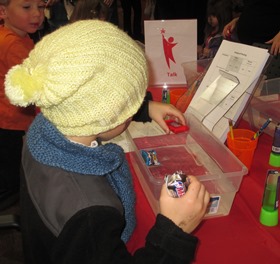
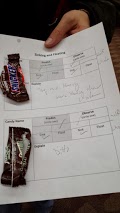
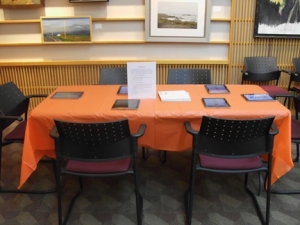
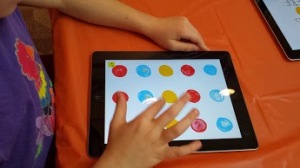
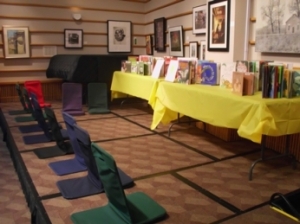
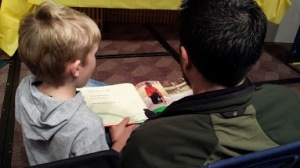
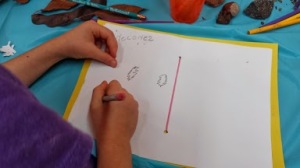


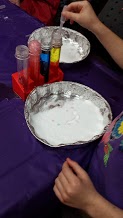
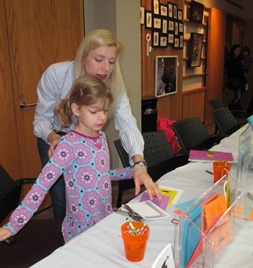
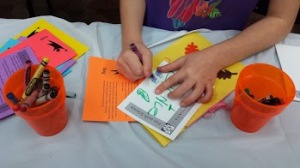
Comments on: "Fun with Science 2013" (2)
[…] Fun with Science […]
[…] Fun with Science 2013 […]